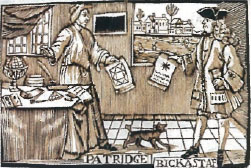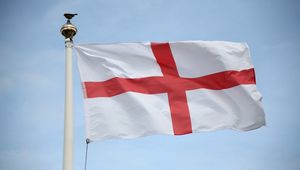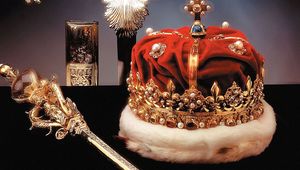
A cobbler-turned-prognosticator meets his match.
[caption id="Timeline29thMarch1708_img1" align="aligncenter" width="162"]

PHILP MOULD, HISTORICAL PORTRAITSITS LTD/BRIDGEMAN ART LIBRARY
[caption id="Timeline29thMarch1708_img2" align="aligncenter" width="251"]

© HULTON ARCHVE
Well, ‘tis as Bickerstaff has guess’d, Tho’ we all took it for a jest; Partridge is dead, nay more, he dy’d E’re he could prove the good ’Squire ly’d….
FOR JONATHAN SWIFT, fact and fiction were often much the same: tools to wield interchangeably to achieve whatever literary or social effect he desired. His fabulous tales published under the title Gulliver’s Travels, while never purported to be anything other than fiction, were told with such narrative skill and wealth of detail that many readers assumed Lemuel Gulliver actually existed and had really travelled to the exotic lands he described. At other times, Swift’s blurring of fact and fantasy was more intentional and less benign. In 1708 he pulled off one of the most audacious gags of all time, in which he targeted another notorious spinner of tall tales.
The victim of Swift’s attention was John Partridge, a cobbler who had discovered that printing astrological almanacs could be a much more lucrative trade than mending worn soles. He began publishing an annual almanac called Merlinus Liberatus, which, he professed, contained accurate prophesies of things to come, as well as attacks against the Church of England. Partridge’s smug pronouncements roused Swift, who detested all forms of fraud and who was himself a conservative churchman. (He would later serve as Dean of St. Patrick’s Cathedral.)
Swift had no patience with astrologers of any kind but seemingly believed that the gullible public needed to be rid of Partridge in particular. And he proceeded to accomplish that end by beating Partridge at his own game. Swift adopted the pseudonym Isaac Bickerstaff and published his own almanac in which he forecast Partridge’s death:
My first prediction is but a trifle,… It relates to Partridge the almanack-maker; I have consulted the stars…and find he will infallibly die upon the 29th of March next, about eleven at night, of a raging fever; therefore I advise him to consider of it, and settle his affairs in time.
[caption id="Timeline29thMarch1708_img3" align="aligncenter" width="644"]

BRITISH HERITAGECOLLECTION
“Bickerstaff” went on to provide a long list of events sure to occur within the ensuing year, declaring “I make bold to tell the world that I lay the whole credit of my art upon the truth of these predictions … .” In other words, if such a great prognosticator as Bickerstaff was proved wrong, then obviously the whole craft of astrology would be revealed as a crock.
Predictably (so to speak) only one of Bickerstaff’s prognostications came to pass—at least according to a cleverly written report. When 29th March had passed, an anonymously written pamphlet appeared in London under the title, “The Accomplishment of the First of Mr. Bickerstaff’s Predictions.” The author, certainly Swift himself, claimed that he had visited Partridge on the evening of the 29th and found the astrologer dying in the manner foretold. Allegedly, Partridge’s final words were:
I am thoroughly persuaded…that Mr. Bickerstaff spoke altogether by guess, and knew no more what will happen this year than I did myself…. I am a poor ignorant fellow, bred to a mean trade, yet I have sense enough to know that all pretenses of foretelling by astrology are deceits…because the wise and the learned, who can only know whether there be any truth in this science, do all unanimously agree to laugh at it and despise it; and none but the poor ignorant vulgar give it any credit, and that only upon the word of such silly wretches as I….
Of course, Partridge was still very much alive, and not at all amused by the whole scam, which Swift had timed to reach a crescendo on April Fool’s Day. In the ensuing issue of Partridge’s almanac he assured readers that the report of his death had been greatly exaggerated and howled at Bickerstaff’s outrageous behaviour, but to little avail. Swift replied that Partridge’s protests only proved that he was indeed dead, for no living person could possibly write such nonsense.
Yet another pamphlet, this one purportedly written by Partridge himself, overflowed with vindictives against Bickerstaff and lamented that people who bumped into Partridge in the street kept remarking how much he resembled the infamous dead astrologer, referring to his wife as “the widow Partridge,” or reminding him that he had yet to pay for the coffin that had been made for him.
‘Swift replied that Partridge’s protests only proved that he was indeed dead, for no living person could possibly write such nonsense.’
By this point the poor astrologer had become a completely ludicrous public figure. Most people certainly recognized what was happening, but it was too good a joke to let the truth interfere. The Company of Stationers in London contributed to Partridge’s embarrassment by issuing an injunction against anyone publishing an almanac in the name of John Partridge. A sensible move, it would seem, since if Partridge was dead, any almanac attributed to him must surely be an attempt to defraud the public.
The final word on the matter though, belonged appropriately enough to Swift, who penned the dear departed’s “epitaph”:
Here, five Foot deep, lies on his Back A Cobler, Starmonger, and Quack; Who to the Stars in pure Good-will, Does to his best look upward still. Weep all you Customers that use His Pills, his Almanacks, or Shoes…










Comments